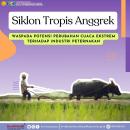Bovine anaplasmosis results from infection with Anaplasma marginale. A second species, A. centrale, is capable of producing a moderate degree of anaemia, but clinical outbreaks in the field are extremely rare. Anaplasma marginale is responsible for almost all outbreaks of clinical disease. The organism is classified in the genus Anaplasma belonging to the family Anaplasmataceae of the order Rickettsiales. The disease is typically transmitted by tick vectors, but mechanical transmission by biting insects or by needle can occur. The most marked clinical signs of anaplasmosis are anaemia and jaundice, the latter occurring late in the disease. Haemoglobinaemia and haemoglobinuria are not present, and this may assist in the differential diagnosis of anaplasmosis from babesiosis, which is often endemic in the same regions. Other signs include rapid loss of milk production and weight, but the clinical disease can only be confirmed by identifying the organism. Once infected, cattle may remain carriers for life, and identification of these animals depends on the detection of specific antibodies using serological tests, or of rickettsial DNA using molecular amplification techniques. Live vaccines are used in several countries to protect cattle against A. marginale infection. Anaplasma centrale vaccine is not entirely safe. A practical recommendation is to restrict its use, as far as possible, to calves. Anaplasma marginale infection has not been reported in humans.
Bovine anaplasmosis
- 12 October 2022
- 3067









